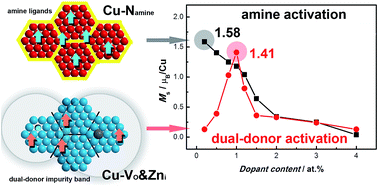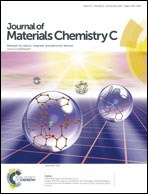Acceptor defect-participating magnetic exchange in ZnO : Cu nanocrystalline film: defect structure evolution, Cu–N synergetic role and magnetic control†
Abstract
Long-term ambiguity in knowledge has made individuals confused about the uncertain origin of magnetism and some defect-related issues in transition metal ions (TMs)-doped ZnO systems. In this paper, a facile colloidal chemistry procedure is employed to prepare amine-capped ZnO : Cu nanocrystals (NCs) with an optimized Cu–N defect configuration. The doping mechanism, dopant spatial distribution, valence state and defect structure are revealed in detail via electron microscopy, electron spin resonance (ESR) and photoluminescence (PL) techniques assisted by in situ chemical tracking. N-capping annealing-induced acceptor defects can activate high-temperature ferromagnetism in spin-coated ZnO : Cu nanocrystalline films, whereas O-capping ones cannot. Although the maximum magnetic moment of surface acceptor defect-mediated ferromagnetic films (1.58 μB/Cu) is comparable with that of a bulk donor defect-mediated case (1.41 μB/Cu), the corresponding physical nature is totally distinct and the former is considered more efficient. A comparative demonstration of the spin-exchange process in terms of acceptor and donor defects strongly indicates a diverse role of defects in mediating ferromagnetic ordering, like the case of carrier type-determined differences in ferromagnetism. The proposal of physical (annealing) or chemical (capping) means for magnetism control in the ZnO : Cu system expands the methodology of applications, which utilize spin and defects as controllable states.


 Please wait while we load your content...
Please wait while we load your content...